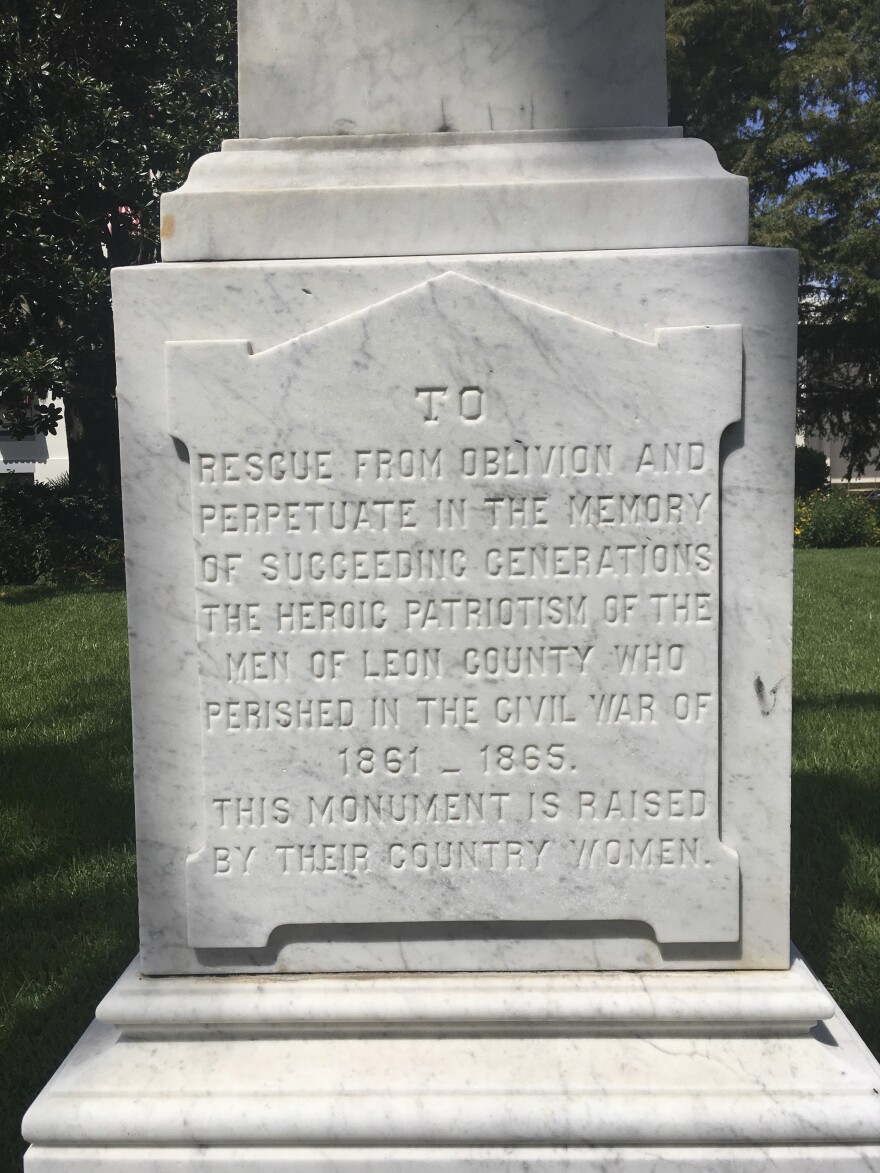There’s a renewed push for Florida’s leaders to remove the confederate monument from the lawn of the Historic Capitol in Tallahassee. It comes as other such monuments are toppling across the state, and the nation.
Leon County Commissioner Bill Proctor’s district includes the Governor’s Mansion – and Proctor is part of a growing group of people who want the Capitol purged of a confederate symbol.
“We have statues out there on the lawn of this Capital, confederate memorial, that need to come down as other things are coming down as other things are coming down,” Proctor said during a visit to the governor’s office this week. “Society is re-examining itself. Society is looking at policies which are oppressive, and those which foster equality and parity.”
Prominent political consultant Kevin Cate, who lives in Tallahassee, wrote a new op-ed that has run in newspapers across Florida in recent days.
“It’s part of a revisionist history used against minorities in our state as a symbol of hatred and false supremacy,” Cate told WFSU.
Cate has been calling for the monument to come down for years. He’s says it isn’t just hurtful to many in the state – he calls what’s written on the monument “fake history.”
“That memorial was not put up for history, because the history is inaccurate: Among other things, it puts Gettysburg in Virginia and makes up three Florida battles that didn’t really happen in a way that should be glorified by anyone,” Cate said Monday. “It was put up as a sort of symbol, a sort of weapon against minorities in our state, and I think the time is long past due for us to bring it down.”
Cate notes others, including state legislators like Representative Geraldine Thompson, have joined in asking for its removal. He adds the monument was moved to its current spot in 1923 at the direction of Florida’s governor. He says current Governor Ron DeSantis has the power to have it removed.
“One of the most frustrating parts about this is the previous administration, Rick Scott, kind of feigned interest in taking it down," Cate said. "Lawmakers feigned interest in taking it down, and they kind of got caught in a limbo of, whose job is it to take it down? Ultimately, it’s the Florida governor’s job.”
Cate says if the governor won’t remove the monument, it would become a job for the Florida Cabinet.
Former state legislator Dwight Bullard, who now heads progressive advocacy group New Florida Majority, addressed the monument during a recent conference call hosted by Florida Democrats. He says it’s a symbol of larger racial disparities in Florida, like those in healthcare, nutrition and banking.
“All those things are intertwined with an institutional and systemic racism, that cannot just be fixed by policy alone. It does take a willingness to change hearts and minds, and more importantly an acknowledgement by people in positions of power around the state that we’ve done wrong,” Bullard said. “You know, right there on the Capitol grounds is still a confederate monument.”
In Gadsden County, a rural community just west of the Capital City, workers removed a confederate monument outside of its courthouse last week.
Gadsden Commissioner Brenda Holt has been bringing the issue before her colleagues for years. She says she first brought up the subect, “in ’08 – and those commissioners weren’t interested in that conversation. But people kept calling, saying that they wanted it taken down.”
A decision was reached by the commission in 2017 to take the monument down, but action was delayed – and when Hurricane Michael struck the region in 2018, it was put on the back burner. Until now.
“Since it was offensive before the Civil War, to slaves, it was offensive to have your dominating class to have you as servants. It was offensive during the Civil War. It was offensive during reconstruction. It was offensive during Jim Crow and Civil Rights (era), it’s just offensive,” Holt said Thursday. “So, at a certain point, you have to say, ‘enough is enough.’”
The Gadsden monument itself was not destroyed, Holt says, but is being stored and is actually up for grabs if an interested party comes to claim it.
“There was no one that we definitely knew that wanted it. So, it was best to just get it and take it down and put it in a safe place so that it couldn’t be vandalized, and give someone the opportunity that wanted it, to get it,” Holt said.
On the Northeast side of the state, Jacksonville city leadership took down a confederate monument from its downtown area. Member station WJCT was on hand for the monument’s dismantling, as was Jacksonville Jaguars running back, Leonard Fournette.
“As y'all seen, we came together. Statue’s gone. That’s another big thing,” Fournette told the crowd, garnering cheers.
Other confederate monuments across the Southeast U.S., and elsewhere in the nation, have come down in recent weeks.


